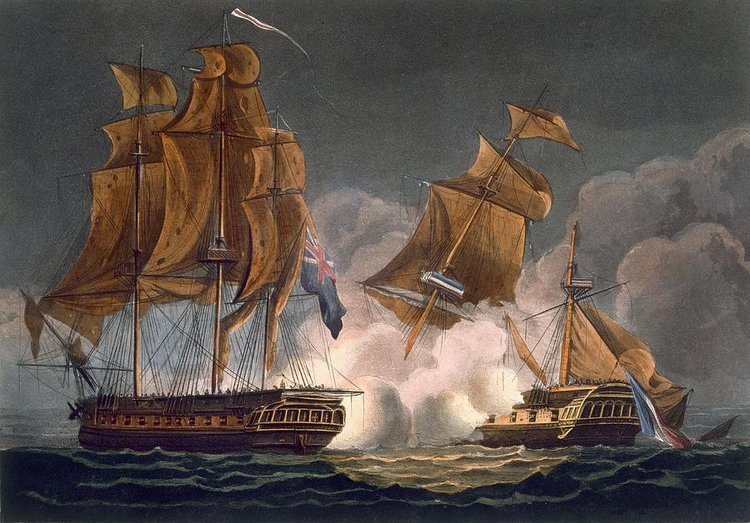A naval captain’s awards and gifts in recognition of meritorious service are springboards to understanding the diversity of his professional career and his versatility as an officer. In the case of Captain Charles Austen, brother of Jane Austen, two special objects merit exploration.[1] I have already written about the significance of Charles’s General Service Medal with its two clasps, one, referred to as “Unicorn 8 June 1796,” was awarded for his participation in the impressive capture of an enemy vessel, La Tribune (44 guns), and the other for the campaign for “Syria[2] Charles received this distinguished British naval award in 1849. A very different mark of grateful recognition of his services occurred in 1827 during Charles’s naval mission to South America. This acknowledgement took the form of a beautifully decorated ceremonial “spadroon.”[3].
Fig. 1: Portrait of Charles Austen and his Sword
“[Charles’s] spadroon is a ceremonial sword with a canon-shaped cross guard and eagle-headed pommel. The loop guard is in the form of a rope, which is held in the eagle’s mouth, and loops around the canon. The grip is made of carved ivory. The steel blade has been etched with decorative patterns, with gilded decoration. The scabbard [or sheath for holding the sword] has been decorated with eagle and sun motifs on one side, and on the other side is inscribed the dedication to Charles Austen from General Simon Bolivar.”[4]
This wonderful artefact connects to a period in 1827, when, as captain of the frigate HMS Aurora (38 guns), Charles was one of the Royal Navy captains stationed in the West Indies. Part of this squadron’s duties was to provide various services of support for General Simon Bolivar, liberator of Spain’s former colonies in South America.
This past summer in England, I tried to find out more about the circumstances surrounding Charles’s receipt of his spadroon. It made sense to follow the clue which the historic inscription on the scabbard of the sword provides. That text reads: “Presented to Charles John Austen, R.N. commanding HMS Aurora at the City of Caracas, 1st March 1827 by Simon Bolivar the liberator of his country as a mark of his esteem.”
I knew that Charles kept a private journal during his years as Captain of HMS Aurora (1826-28). His writings are contained in nine notebooks in the collection of the Caird Library, which is part of the National Maritime Museum, Greenwich, London. Once at the Caird Library, I expected to discover Charles’s entry for 1 March 1827 would provide a description of the sword’s presentation at a Venezuelan location, probably accompanied by Charles’s impressions of Bolivar. This was not the case. As Charles’s journal entry for that date reveals, he spent time at a Dockyard (most likely in Antigua) during the day.[5] That evening he entertained guests for dinner, the party concluding with “cards and liquors in the after cabin [of the Aurora].”[6] As further research revealed, Charles did not meet Bolivar until 20 April 1827, 50 days later.
So here was a mystery. Where and when did Bolivar present the sword and for what reasons did he select Charles for this honour? Answering this question will provide a glimpse of how Charles undertook various assignments, and activities which would not ordinarily occupy a naval captain on a station.
In a later post, I plan to place Charles’s receipt of the sword in the context of his career, exploring how, for a short period, Charles played a small part in British international diplomacy in South America. That narrative will also introduce several interesting individuals with whom Charles interacted: the artistic and ambitious British Consul in Caracas, Venezuela, Sir Robert Ker Porter, the Honorable Alexander Cockburn, His Majesty’s Envoy Extraordinary to the Columbian States, and the flamboyant and dynamic General Simon Bolivar, the illustrious military and political leader, who was known to his people as the Liberator and hero of the South American revolution. During his time in Caracas, Charles was welcomed by these men into the social and diplomatic life of the city.
[1] Owned by Austen descendent David Willan.
[2] See my blog for 26 May 2023, “Honouring Jane Austen’s Naval Brother Charles: The Story of his General Service Medal.” I have been recently told that Charles’s medal is very rare because of the two clasps. I thank Nick Ball of the Chatham Historic Dockyard for explaining to me that only four “Unicorn” claps were awarded, so the combination of one with the more common “Syria,” is almost certainly unique.
[3] A spadroon was lighter than a broad sword, because it was designed to both cut and thrust.[3] Earlier this year, Charles’s sword became part of the exhibit “Command of the Ocean,” at the Historic Dockyard, Chatham, Kent, England.
[4] Many thanks to the sword’s owner, David Willan for the fine detailed description of its appearance.
[5]Antigua is the most likely location as Charles’s guests included Captain and Mrs Wilson of the 93rd, a Regiment, which was stationed there.
[6] Charles Austen, Private Journal, 1 March 1827, AUS/121.
























